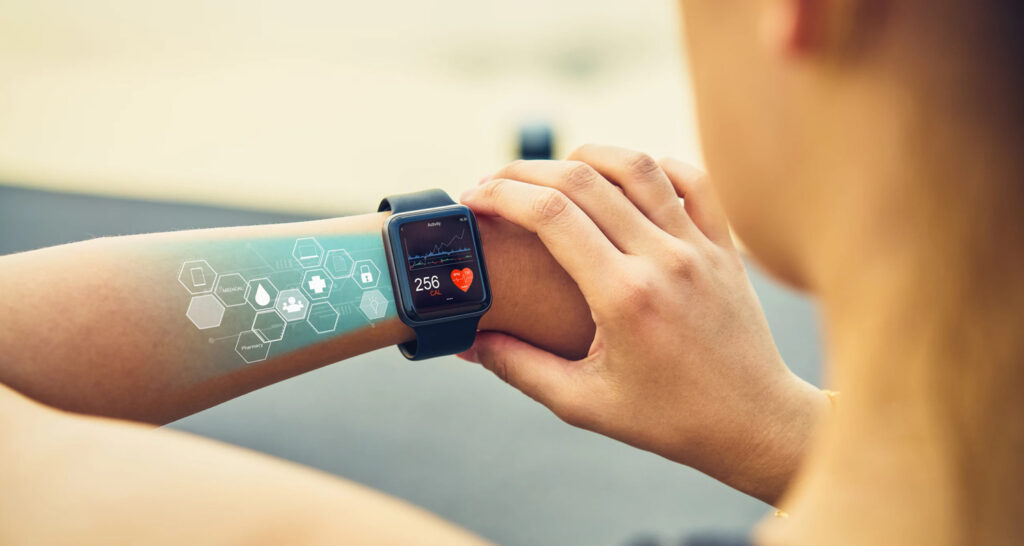Artificial Intelligence, or AI, is a type of technology that imitates human intelligence and can perform tasks like learning, problem-solving, and decision-making. AI encompasses various technologies like machine learning, natural language processing, computer vision, and robotics. Its applications are vast and can be used in healthcare, finance, education, manufacturing, transportation, entertainment, and other areas. AI systems can analyze large amounts of data, identify patterns, and make predictions or recommendations based on insights gleaned from the data. Overall, AI has the potential to change how we live, work, and interact with technology in the modern world.
Current State of Wearable Technology

In today’s tech-savvy world, wearable technology has become increasingly prevalent, revolutionizing how we interact with the digital realm. Smartwatches, such as the Apple Watch and Samsung Galaxy Watch, have emerged as popular accessories, offering functionalities ranging from notifications and fitness tracking to contactless payments and voice commands. Fitness trackers like Fitbit and Garmin have become essential tools for health enthusiasts, monitoring everything from heart rate and sleep patterns to step counts and calorie intake.
Augmented reality (AR) glasses like Microsoft HoloLens and Google Glass are reshaping how we perceive and interact with the world around us, blending digital content seamlessly into our physical environment. These devices hold immense potential across various sectors, from healthcare and education to manufacturing and entertainment.
Recent Advancements in Wearable Technology

In recent years, wearable technology has seen remarkable advancements that are reshaping its capabilities and potential impact on our lives. One significant area of progress is in health monitoring capabilities, with wearables now able to track a wider range of health metrics with greater accuracy. Devices like smartwatches and fitness trackers are equipped with advanced sensors that can monitor heart rate variability, detect irregularities in heart rhythm, and even measure blood oxygen levels.
Integration with artificial intelligence (AI) is another notable advancement in wearable technology. AI algorithms analyze data collected by wearables to provide personalized insights and recommendations for improving health and fitness. This integration enhances the user experience by offering tailored guidance and actionable insights based on individual data.
Recent advancements have led to enhanced user interfaces, making wearables more intuitive and user-friendly. Touchscreens, voice commands, and gesture controls are becoming increasingly common, allowing users to interact with their devices more seamlessly and efficiently. These advancements signify the ongoing evolution of wearable technology, promising even more sophisticated and impactful innovations in the future.
Applications of Wearable Technology Across Industries

Wearable technology has transcended traditional consumer applications and found its way into various sectors, revolutionizing how industries operate and interact with technology. In healthcare, wearables are invaluable tools for monitoring patient health remotely, tracking vital signs, and managing chronic conditions. Fitness enthusiasts rely on wearable devices for tracking workouts, monitoring activity levels, and setting fitness goals, fostering a culture of wellness and accountability.
Wearable technology is transforming entertainment and gaming experiences, offering immersive virtual reality (VR) and augmented reality (AR) interactions. In business settings, wearables enhance productivity and efficiency by providing hands-free access to information, enabling workers to receive real-time notifications, access data, and communicate seamlessly.
The potential impact of wearable technology on various sectors is vast, promising improved patient outcomes, enhanced fitness and wellness, immersive entertainment experiences, and increased productivity in business operations. As wearables continue to evolve, their applications across industries will only expand, shaping the future of technology-driven innovation.
Exploring Emerging Trends in Wearable Technology

As wearable technology continues to evolve, several emerging trends are reshaping the landscape, paving the way for innovative applications and enhanced user experiences. One notable trend is the emergence of smart clothing, integrating electronic components and sensors into garments to monitor biometric data, track movement, and enhance comfort and performance.
Advancements in biometric authentication are driving the adoption of wearable devices for secure access control and identity verification. Biometric sensors embedded in wearables enable seamless authentication through features like fingerprint recognition, facial recognition, and even heart rate variability.
The integration of wearable devices with Internet of Things (IoT) ecosystems is gaining momentum, enabling interconnected smart devices to communicate and collaborate seamlessly. Wearables are becoming integral components of IoT networks, facilitating data exchange, automation, and personalized experiences across various domains, from healthcare and fitness to home automation and industrial applications.
Challenges and Opportunities in Wearable Technology

While wearable technology presents exciting opportunities for innovation and advancement, it also comes with its fair share of challenges. One of the primary concerns is data privacy, as wearable devices collect sensitive personal information that must be safeguarded against unauthorized access and misuse. Additionally, battery life limitations pose a challenge, requiring manufacturers to balance functionality with energy efficiency to ensure optimal device performance.
Design constraints, such as size, weight, and comfort, can impact user adoption and satisfaction, necessitating careful consideration of ergonomic factors and aesthetic appeal. Despite these challenges, the wearable technology industry continues to thrive, driven by a growing demand for connected devices and personalized experiences.
Opportunities for innovation abound, with advancements in materials science, sensor technology, and data analytics paving the way for breakthroughs in wearables. As the industry evolves, there is immense potential to address consumer needs, enhance usability, and expand into untapped markets, driving continued growth and development in this dynamic field.
Envisioning the Future of Wearable Technology

As technology continues to advance at a rapid pace, the future of wearable devices holds immense promise for transformative breakthroughs. One area poised for significant development is wearable health monitoring, where innovations in sensor technology and data analytics could enable real-time tracking of vital signs, early detection of health issues, and personalized health recommendations.
The integration of brain-computer interfaces (BCIs) with wearable devices opens up exciting possibilities for seamless interaction between humans and machines. This could revolutionize communication, control, and accessibility, empowering individuals with disabilities and enhancing human capabilities in various domains.
The evolution of wearable technology is expected to extend beyond functionality to encompass fashion-forward design and style. With a growing emphasis on aesthetics and personal expression, future wearable devices may seamlessly blend into everyday attire, enhancing both form and function.
Shaping Society through Wearable Technology

The widespread adoption of wearable technology has the potential to profoundly impact various aspects of society, ushering in significant changes in healthcare, lifestyle behaviors, and human-computer interaction. In healthcare, wearable devices offer unprecedented opportunities for preventive care, remote monitoring, and personalized treatment plans. By providing real-time health data and insights, these devices empower individuals to take proactive measures to manage their well-being, improving health outcomes and reducing healthcare costs.
Wearable technology influences lifestyle behaviors by promoting fitness, encouraging healthy habits, and fostering greater awareness of daily activities. From tracking physical activity to monitoring sleep patterns, these devices motivate individuals to make positive lifestyle choices and adopt healthier routines.
The integration of wearable technology into everyday life reshapes human-computer interaction, blurring the boundaries between the digital and physical worlds. With seamless access to information, communication, and entertainment, wearable devices enhance convenience, productivity, and connectivity, revolutionizing how individuals interact with technology in their daily lives.
Navigating Wearable Technology Adoption
For individuals and businesses considering the adoption of wearable technology, it’s crucial to approach the decision with careful consideration and planning. Firstly, when selecting devices, it’s essential to assess their compatibility with existing systems, user interfaces, and desired functionalities. Conducting thorough research and reading user reviews can help in making informed decisions.
Prioritizing data security is paramount, especially for businesses handling sensitive information. It’s crucial to choose devices with robust encryption protocols and implement strict access controls to protect confidential data.
Furthermore, integrating wearable devices into daily routines or business operations requires careful planning and training. Providing employees with proper guidance and training on device usage and data management can help maximize the benefits of wearable technology adoption while minimizing potential risks.
By considering these practical tips and considerations, individuals and businesses can navigate the adoption of wearable technology effectively, unlocking its full potential to enhance productivity, efficiency, and overall well-being.
